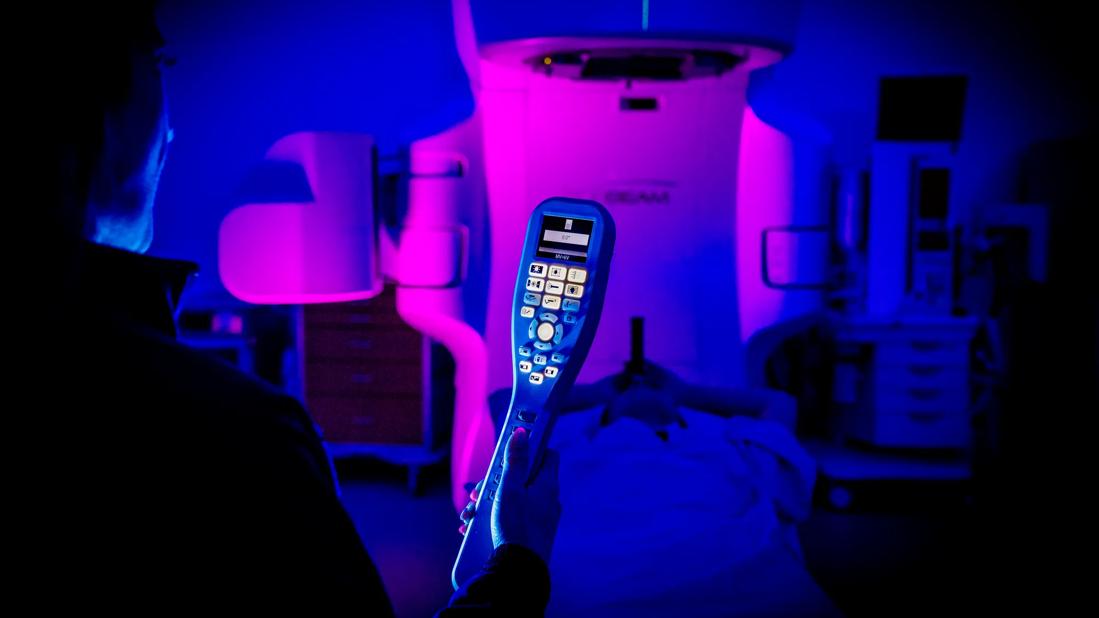Radiation therapy produces anti-inflammatory response

Low-dose radiation therapy was used years ago to treat some benign conditions like osteoarthritis but the emergence of NSAIDs like ibuprofen and acetaminophen supplanted that treatment in the U.S. in recent decades. However, studies showing high efficacy rates of low-dose radiation therapy are spurring a resurgence of this treatment, which is now available at Cleveland Clinic locations.
Advertisement
Cleveland Clinic is a non-profit academic medical center. Advertising on our site helps support our mission. We do not endorse non-Cleveland Clinic products or services. Policy
Recently, a 95-year-old woman benefited from this therapy. She had been very active despite multiple orthopaedic issues and use of a rollator to support her walking. Right knee pain began to limit her mobility and frustrate her. In the past, her orthopaedist prescribed various treatment strategies, including medication, but they didn't provide lasting relief.
The patient met with Cleveland Clinic radiation oncologist Phillip Engeler, MD, who reviewed her case, including x-rays, which showed bone-on-bone in her knee. After evaluating the patient and ruling out other causes of pain, Dr. Engeler deemed her an excellent candidate for the therapy.
For osteoarthritis, the ideal candidates for low-dose radiation therapy are patients over 65 who are no longer responding to medications or have not been able to tolerate their side effects. After meeting Dr. Engeler, the patient was enthusiastic about trying the approach to help her resume more physical activity.
For many patients, non-steroidal medications can lose effectiveness over time. It’s also risky for some older patients to remain on these medications long term, since they can affect other organs. Low-dose radiation therapy can be an alternative to these treatments.
“Studies show that at very low doses, radiation has an anti-inflammatory effect," explains Dr. Engeler. "Usually in our cancer center, we're using high-dose radiation to curb abnormal cell growth. In this case, low doses are believed to modulate the pathways that are involved with inflammation, leading to an anti-inflammatory response and helping to alleviate pain." By decreasing inflammation, the therapy slows disease progression in several benign conditions.
Advertisement
With the explosion of scientific knowledge about radiation therapy in recent years, there is a deeper understanding of how this treatment works at low doses. “The ability to deliver a small field of radiation therapy to a target area has dramatically improved over the last 10-20 years,” explains Cleveland Clinic radiation oncologist Matthew Ballo, MD. “Radiation treatment can be directed in a way that eliminates scatter that was common years ago.”
The patient received six treatments of 50 cGy daily over a two-week period, for a total of 300 cGy. Then after a two-month break, she repeated the same cycle.
As with any radiation therapy, a multidisciplinary approach was warranted. After the patient experienced relief in her knee, she inquired about using radiation therapy to address pain in her shoulder. She had a preexisting large fluid collection in her shoulder capsule in addition to a history of ongoing osteoarthritis. The radiation team collaborated with her orthopaedist to discuss the best approach. Together, they decided to leave the fluid intact and initiate a second course of radiation therapy for her right shoulder. The shoulder treatment is now under way.
“We’re seeing partial or complete pain relief in between 60-90 percent of patients,” says Cleveland Clinic radiation oncologist Rahul Tendulkar, MD. In this case, the patient was able to get around better and experienced a decreased level of pain in her right knee by the end of the treatment course directed to her knee. She tolerated the therapy well, with no side effects.
Advertisement
“When you’re radiating an arthritic joint it’s typically at a dose about 1/20th the amount we’d use to treat cancer, so there should be no noticeable adverse events,” says Dr. Tendulkar. “Radiation at this low a dose doesn’t tend to cause injury to tissue. It simply changes the inflammatory environment in a positive way.”
Advertisement
Advertisement
Advertisement

Phase 2 study brings pivotal advances in treatment efficacy and safety for the most challenging-to-treat population

Patient with quadruple refractory multiple myeloma achieves complete response with cell therapy

Distinct baseline immune profiles can predict response and resistance to different types of CAR-T cells.

National Blood Clot Alliance collaborates with faith-based organizations on first-of-its-kind church bus tour

AI-driven tools can streamline enrollment and improve efficiency across clinical trials.

Patient achieves complete remission from aggressive marginal zone lymphoma with liso-cel

Supporting patients during pregnancy and beyond

Real-world applications in clinical documentation and trial matching